Light Pollution: professional astronomers give a very bad example

A memorable afternoon. Meeting Jayant Narlikar & Halton Arp
April 29, 2010
Blogging from Chile
August 23, 2010Light pollution is a serious issue, and it does not affect only astronomers. If you wish to get a nice introduction on the subject, visit the wikipedia page; it contains lots of useful links and references to literature and web sites.
Usually, the two words “light pollution” bring to your mind images of densely populated areas, full of commercial, public and private outdoors lighting. In many cases just throwing light into the skies, either because of bad lamp design or (even worse) on purpose. This is the case for the building portrayed in the picture here to the left. This photonic phallic symbol (I do not know what other name one may use), is the essence of energy wasting. Besides being totally useless, it shows a blatant contempt of nature and its rights. Let alone the complete lack of respect for the taxpayer. You can get more details on this monster at this link. Of course the world is full of such things, so that we are sending upwards a huge amount of useless light, whose only purpose might be to facilitate the landing of alien star-ships. You can see a nice collection of very bad lighting examples (collected in Italy) at the web site of Cielo Buio, the Italian dark sky association.
As an optical astronomer I am particularly sensitive to this problem, and in the last years I have started taking some public action. You might remember my participation to the conference of the International Commission on Illumination in Vienna. If you are interested in a professional astronomer’s point of view, you can find my paper here. One of the very basic recommendations to mitigate the problem of light pollution (and to save energy and reduce CO2 emission) is to use artificial outdoors lighting only when strictly necessary (both in space and time), and to avoid any emission above horizontal (lamps should have the so-called Upward Light Output Ratio equal to 0%). Because of the financial recession, dark sky activists had some successes in the last years, because the argument of energy saving was (and still is) a good one to convince politicians and tax payers that good money could be saved just, well…, switching off useless lights. A real example? In my village, north-east of Italy, since a couple of years every second street lamp is switched off after midnight (with some exception at crossroads). The results? A significant energy saving, with no additional expenses and no complaints from the citizens. Easy, uh? Admittedly, I have been lobbing a bit to obtain that 😉
Truly enough, professional astronomers should all be very sensitive to this problem. And the fact that they work in the mid-IR or in radio, should be no excuse.
Well, this is absolutely not the case. I will show here just an example, to make things clear. A colleague of mine, working in Italy and very active in the field of light pollution, has brought to my attention the fact that the largest Italian radio-telescope, located in Medicina (Bologna), is illuminated during the night. The purpose of this is mysterious. Radio-astronomers are well aware of the problem of electromagnetic interferences, which pose a serious treat to their observations. Nevertheless, they illuminate their own scientific equipment just for the fun of it (I do not see any other reason). Obviously the electromagnetic radiation emitted by those bright lamps is armless for their science. And so, who cares? It is also obvious that switching off those lights would not solve the problem of light pollution in the Italian peninsula (and believe me, it is a bright place!). But it would at least give a clear example and show coherence.
How can we address administrators and politicians, tell them that they should replace their fixtures, use less light, deploy time controls, switch off lamps in empty parking lots, reduce the emissions above horizontal and so on when some of our main scientific facilities constitute a clear violation of all those requirements? Indeed, it is a paradoxical situation. Immediately after I was made aware of this, I wrote a letter to the director of the radio-telescope, and the director of the Italian National Institute for Astrophysics. That was more than two weeks ago. Guess what? No answer… I thought I had at least shared my disappointment with you 😉
We are now going one step further, asking the International Astronomical Union to take the appropriate actions. Let’s see what comes out of it.
I close this somewhat sad post with a sequence of images I have been downloading from the web site of the radio-observatory since a few hours. They have been taken by a webcam which is continuously watching the parabola. As you will see, the lights have been turned on around 20:50 CET. It is now 00:35 CET and lights are still on.
I would be curious to see when the lights are switched off. I guess at sunrise, but I am not sure I am willing to check this tonight 😉 But if you happen to be somewhere around the world in a favorable timezone, just take a look, download the image and send it to me. I’ll add it to the sequence.

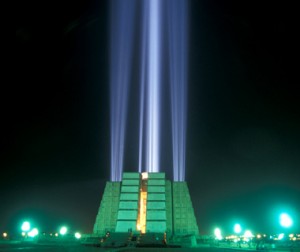
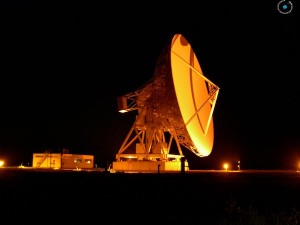
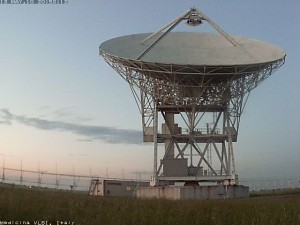
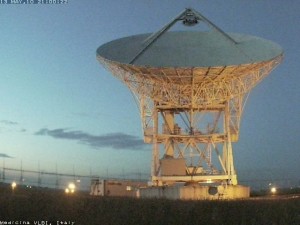
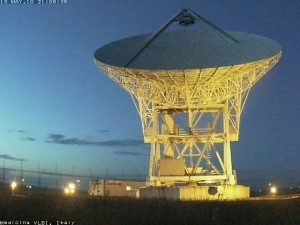
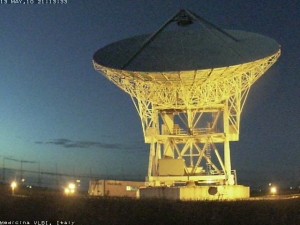
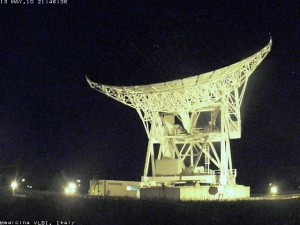
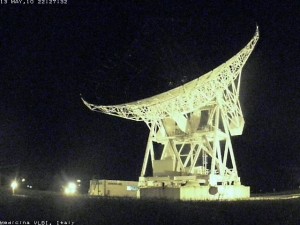
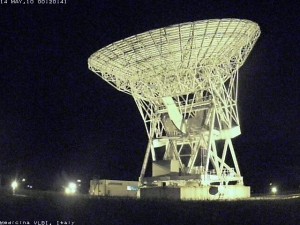

2 Comments
This is a great blog! Glad to see I’m not the only amateur astronomer out there who appreciates getting to see the stars now and then.
Dark Sky Compliance | Outdoor Lighting 101
It’s really disappointing to see that professional astronomers don’t consider this more of an issue. It couldn’t be so difficult to set up timers or sensors on these things…
Thanks.